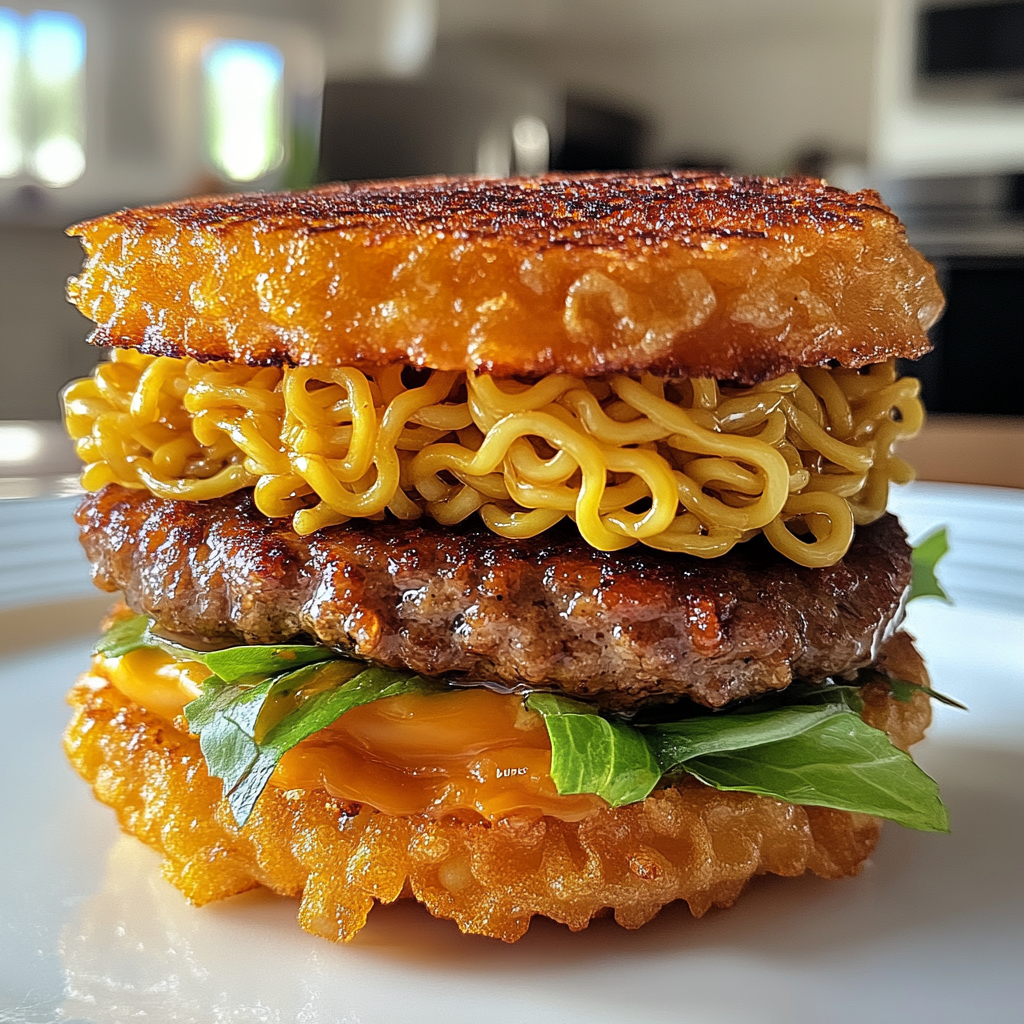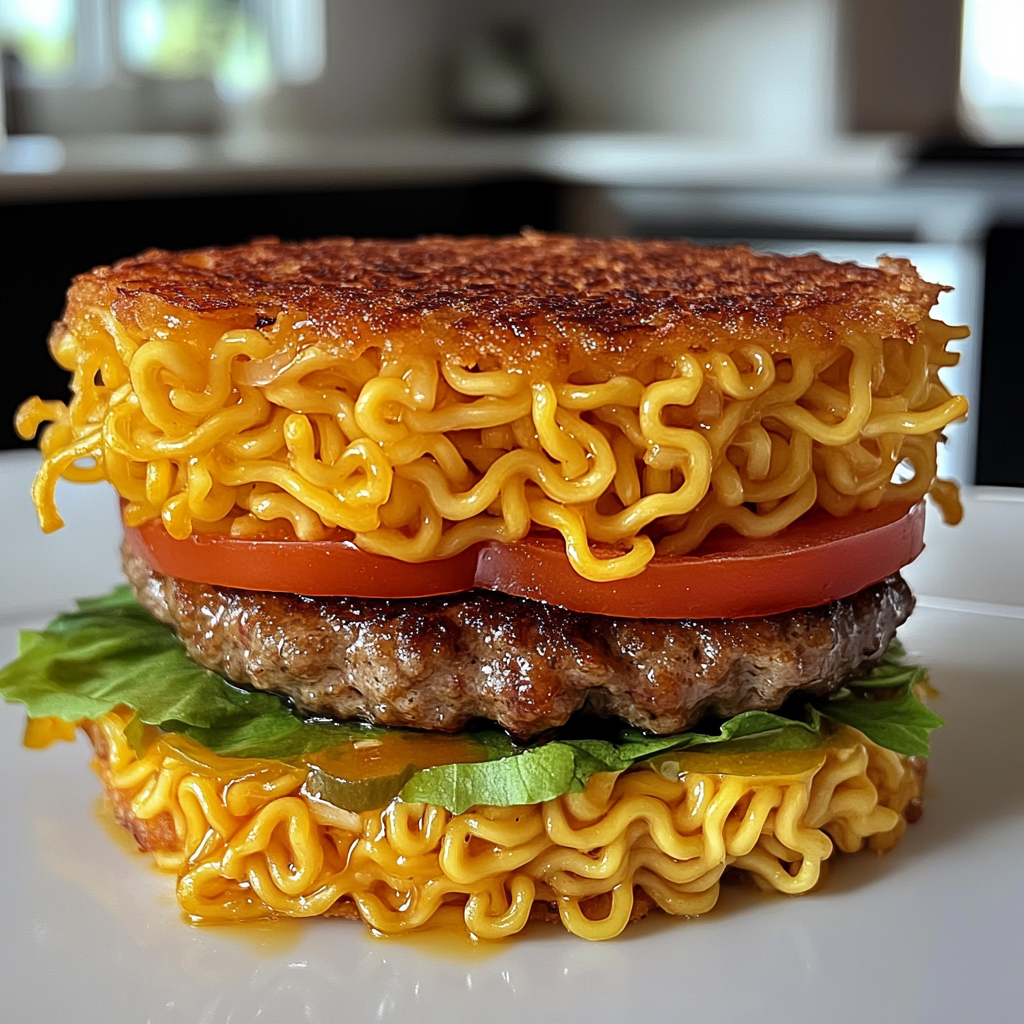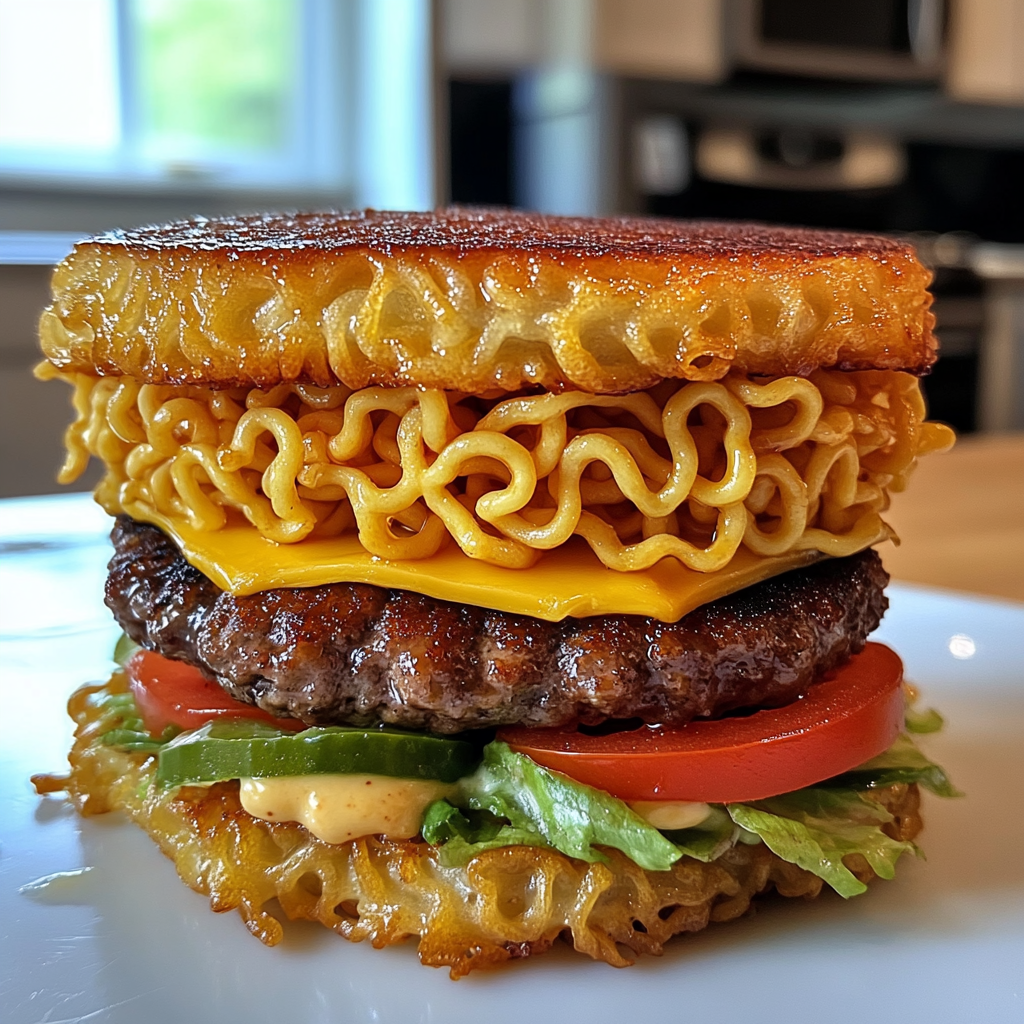Ramen Burgers combine the comfort of traditional noodle dishes with the classic appeal of a burger. This guide explores everything you need to know to make your own, along with creative variations, health benefits, and chef insights that have made this innovative dish a viral phenomenon.
What are Ramen Burgers?
Ramen Burgers are a culinary creation that uses compressed ramen noodles in place of traditional bread buns. This unique twist features a savory patty nestled between two crispy noodle “buns,” offering an unexpected mix of textures and flavors that has captured the attention of food enthusiasts worldwide.
The Origin of Ramen Burgers
Keizo Shimamoto and His Creation
Keizo Shimamoto, a passionate ramen aficionado, invented this noodle-based creation and debuted it at Smorgasburg in Brooklyn, New York. His inventive combination of ramen and a burger patty quickly became a sensation as crowds flocked to try something radically different. Shimamoto’s vision was to fuse his love for classic American fare with his deep appreciation for traditional Japanese noodles, ultimately giving birth to a dish that challenges culinary norms.
Smorgasburg and the Ramen Burger Phenomenon
At Smorgasburg—a sprawling outdoor food market celebrated for innovative culinary experiments—the dish’s unique appeal led to long lines and rapid word-of-mouth buzz. Its debut sparked widespread interest among both local foodies and international audiences, eventually inspiring countless variations across restaurants and home kitchens.
Why Ramen Burgers Are So Popular
This dish’s rapid rise to fame can be attributed to several factors:
- Novelty: Its unique construction sets it apart from regular burgers.
- Texture: The crispy, seared noodle buns provide a satisfying crunch that contrasts with a juicy patty.
- Flavor: The inherent savoriness of ramen perfectly complements the meat (or alternative protein) inside, creating a layered taste experience.
- Visual Appeal: Its striking presentation makes it highly shareable on social media, further fueling its popularity.

The Unique Taste and Texture of Ramen Burgers
The success of this innovative dish lies in its textural contrast. The noodle “buns” are seared until they achieve a golden, crispy exterior while maintaining a soft interior. When paired with a well-seasoned patty, the dish delivers a balance of hearty and delicate flavors. The natural umami from the noodles, enhanced by seasonings such as soy sauce and sesame oil, creates a memorable culinary experience that keeps enthusiasts coming back for more.
Ramen Burgers and Social Media Trends
Visual platforms like Instagram and TikTok have played a critical role in popularizing this dish. Its striking appearance—coupled with the dramatic sizzle of searing noodles—has led to countless shares, likes, and video recreations. Food influencers and everyday diners alike post photos and videos, turning this innovative dish into a social media staple.
Key Ingredients for Ramen Burgers
The quality and balance of ingredients are essential for perfecting this dish. Here are the primary components:
- Ramen Noodles: Use high-quality noodles, whether fresh or using an unseasoned instant variety, that maintain their structure after cooking.
- Eggs: These are critical for binding the noodles together to form sturdy buns.
- Burger Proteins: Options include ground beef, chicken, pork, tofu, or black beans—each providing a different flavor profile.
- Sauces and Seasonings: Soy sauce, sesame oil, garlic, and ginger enhance the overall taste.
- Toppings: Scallions, sesame seeds, sriracha, mushrooms, and even a fried egg can elevate the dish further.
Choosing the Right Ramen Noodles for Your Burger
Selecting the perfect noodles is crucial. Fresh ramen noodles are often ideal, but many home cooks use unseasoned instant ramen. The key is that they must be robust enough to hold their shape after being formed into buns. Experimenting with different brands or noodle types may lead to surprising flavor nuances.
Selecting the Perfect Burger Proteins
While ground beef is a traditional favorite, the dish is versatile enough to accommodate other proteins. Chicken or turkey offer a leaner alternative, and for a vegetarian twist, tofu or black bean patties are excellent choices. Each option changes the overall flavor and texture, allowing for creative customization.
How to Make Ramen Burgers: A Step-by-Step Guide
Follow these detailed steps to create your own version of this inventive dish:
- Cook the Ramen: Prepare the noodles according to package directions. Ensure they remain just tender.
- Bind the Noodles: In a large bowl, whisk eggs with soy sauce and sesame oil. Add the cooked noodles, mixing thoroughly.
- Shape the Buns: Divide the mixture into equal portions and shape each into a compact, bun-like form.
- Chill the Buns: Refrigerate the formed buns for at least 30 minutes to allow them to firm up.
- Prepare the Protein: Season your chosen burger protein (e.g., ground beef) with salt and pepper, and form patties.
- Sear the Buns: Heat a lightly oiled skillet over medium heat and sear each bun for 3–4 minutes per side until they are golden and crispy.
- Assemble the Burger: Place the cooked patty between two noodle buns and add your desired toppings.
Cooking and Preparing the Ramen Noodles
For the perfect texture, cook the noodles until just tender—overcooking may lead to soggy buns. Drain them thoroughly to remove excess water. This step is critical, as any residual moisture can compromise the crispiness of the final product.
Shaping and Chilling the Noodle Buns
After combining the noodles with the egg mixture, divide the mass evenly into portions that are then shaped into buns. Firmly press each portion to ensure a compact structure. Chilling in the refrigerator for at least 30 minutes is essential, as it helps the buns maintain their shape during searing.
Searing the Noodle Buns for the Perfect Crunch
A hot skillet is vital for achieving a crispy exterior. Sear the chilled buns on medium heat until each side is golden brown and crisp. Avoid overcrowding the pan to ensure even cooking. This step enhances the texture and locks in the flavors of the noodles.
Tips for Perfect Noodle Buns
Achieving the ideal bun takes practice. Here are a few tips:
- Adequate Egg Usage: Make sure to use enough eggs to bind the noodles thoroughly.
- Firm Pressing: When shaping, press the mixture firmly so that it holds together during cooking.
- Proper Chilling: Don’t skip the chilling step; it is crucial for maintaining shape.
- Batch Cooking: Work in small batches to avoid overcrowding and ensure even searing.
- Medium Heat Cooking: Use medium heat to prevent burning while allowing the buns to crisp evenly.
Binding Noodles Effectively
The binding process is critical. Eggs not only act as a glue but also add richness to the dish. Make sure the noodles are evenly coated with the egg mixture. This ensures that when you shape and sear the buns, they hold together and deliver a consistent texture in every bite.
Achieving Crispy Noodle Buns Every Time
Consistency in texture is key to enjoying this dish. A preheated, lightly oiled skillet and a patient, slow sear allow the buns to develop an even, golden crust without sacrificing the soft interior. Experiment with slight adjustments in cooking time and temperature until you perfect your technique.
Best Burger Proteins for Your Creation
This dish pairs well with a variety of proteins. Here are some of the most popular choices:
- Ground Beef: The classic option known for its rich flavor.
- Chicken: A leaner alternative that still delivers great taste.
- Pork: Offers a slightly different flavor profile that complements the noodles.
- Tofu: Ideal for vegetarians, tofu absorbs seasonings beautifully.
- Black Bean: Provides a hearty, plant-based alternative with a satisfying texture.
Ground Beef: A Classic Pairing
The traditional choice for many, ground beef’s robust flavor pairs seamlessly with the seasoned noodles. Its natural juices and rich taste enhance the overall experience.
Vegetarian and Vegan Protein Options
For those who prefer a meatless version, tofu or black bean patties are fantastic alternatives. Ensure they’re well-seasoned to pack a punch of flavor that stands up to the bold noodles.
Sauces and Toppings That Compliment the Dish
The right sauces and toppings can elevate this creation to new heights. Here are some excellent options:
- Soy Sauce: Provides a deep umami flavor.
- Sesame Oil: Adds a subtle, nutty aroma.
- Sriracha: Delivers a spicy kick that contrasts with the savory noodles.
- Scallions: Fresh and crisp, they add a mild onion flavor.
- Sesame Seeds: Enhance the visual appeal and contribute a pleasant crunch.
- Mushrooms: For an earthy note, sautéed mushrooms work wonderfully.
- Fried Egg: A runny yolk can add a rich, velvety texture.
- Pickled Ginger: Offers a tangy burst that cuts through the richness.
- Furikake: A sprinkle of this seasoning adds layers of flavor and texture.
Creating the Perfect Sauce
A harmonious blend of soy sauce, sesame oil, honey, ginger, and garlic can create an unforgettable sauce. This mixture serves as a perfect complement, intensifying the flavors without overpowering the dish.
Additional Topping Ideas for an Elevated Experience
Beyond the basics, consider incorporating ingredients like kimchi for a tangy zest, avocado for creaminess, or even crunchy fried onions for extra texture. These toppings can be mixed and matched to suit your taste and create a personalized version of this dish.

Creative Variations and International Twists
Innovation never stops in the culinary world. Chefs worldwide have embraced this noodle-based burger, experimenting with regional ingredients and cooking styles. Here are a few international twists:
Asian Fusion Variations
- Teriyaki Chicken Version: Replace the traditional beef patty with marinated chicken glazed in a sweet teriyaki sauce. Top with pickled daikon and shredded cabbage for a refreshing crunch.
- Spicy Kimchi Edition: Incorporate chopped kimchi into the noodle mixture or use it as a topping to introduce a tangy, spicy element.
Western-Inspired Adaptations
- BBQ Pulled Pork: Use slow-cooked pulled pork as the filling, complemented by a tangy barbecue sauce and crisp coleslaw. This version merges Southern barbecue traditions with the playful texture of the noodle buns.
- Veggie Delight: For a lighter option, create patties with a blend of black beans, corn, and spices. Add avocado slices and a drizzle of lime-infused crema for a fresh finish.
Health-Focused Variations
- Gluten-Free Options: Substitute traditional ramen with a gluten-free noodle variety, paired with lean protein and fresh vegetables, to cater to health-conscious diners.
- Low-Fat Creations: Use lean ground turkey or chicken and minimize oil during cooking to create a healthier version without sacrificing flavor.
Health and Nutritional Benefits
While often celebrated for its novelty and taste, this dish can also be tweaked to align with health goals:
Nutritional Profile of the Noodle Buns
The base of this dish provides complex carbohydrates and a moderate amount of protein from the eggs. When prepared with minimal added fats, the noodle buns can be a lighter alternative to bread-based burgers.
Protein Options and Their Benefits
Opting for lean proteins such as chicken or turkey can lower the overall fat content while still providing the necessary protein. Vegetarian options like tofu and black beans offer fiber and essential nutrients, making the dish versatile for different dietary needs.
Incorporating Fresh Vegetables
Adding fresh vegetables—such as leafy greens, tomatoes, and bell peppers—either as toppings or side dishes can boost the vitamin and mineral content. This not only improves the nutritional profile but also adds vibrant colors and textures to the plate.
Tips for Healthier Preparation
- Less Oil, More Flavor: Use cooking sprays or minimal oil when searing the buns to reduce unnecessary calories.
- Whole Ingredients: Incorporate fresh herbs and vegetables in both the patties and toppings to enhance flavor naturally.
- Balanced Sauces: Opt for sauces that offer flavor without excessive sugar or sodium. Consider making your own dressings with natural sweeteners like honey or maple syrup.
Pairing Suggestions and Side Dishes
To create a complete meal, consider pairing this innovative dish with complementary sides and beverages:
Ideal Side Dishes
- Asian-Inspired Slaw: A crisp slaw made with cabbage, carrots, and a light rice vinegar dressing can provide a refreshing contrast.
- Sweet Potato Fries: Baked sweet potato fries offer a naturally sweet and healthy alternative to traditional fries.
- Edamame Beans: Steamed edamame sprinkled with sea salt serves as a nutritious, protein-packed side.
Beverage Pairings
- Iced Green Tea: The subtle bitterness of green tea can balance the savory and umami notes of the dish.
- Craft Sodas: Consider artisanal sodas flavored with ginger or yuzu to add a bright, citrusy contrast.
- Light Beers: A crisp lager or pilsner pairs well, especially with the richer protein options.
Dessert Complements
Finish the meal with a light dessert that echoes the fusion concept:
- Mochi Ice Cream: This Japanese treat is both refreshing and complements the innovative nature of the main dish.
- Fruit Salad with a Twist: Incorporate tropical fruits with a splash of lime juice for a tangy, palate-cleansing finish.
Chef Insights and Cultural Impact
Renowned chefs around the world have embraced this noodle-based burger, crediting it with opening new avenues in fusion cuisine. Their insights reveal several key points:
Culinary Innovation and Experimentation
Chefs emphasize the importance of experimentation in the modern culinary landscape. By blending elements from different cultures, they create dishes that are both familiar and innovative. This dish, for example, is celebrated for its ability to merge the comforting nature of noodles with the hearty appeal of a traditional burger.
The Role of Social Media in Shaping Food Trends
Social media platforms have redefined how food trends emerge and evolve. Influencers and professional chefs alike share their versions of this dish online, inspiring countless home cooks to try their hand at recreating it. The visual appeal and ease of customization have turned it into a viral sensation that continues to evolve.
Community and Cultural Exchange
This dish has become a symbol of culinary exchange—a representation of how global influences can combine to create something entirely new. Its popularity at food markets and pop-up events underscores the importance of community-driven food experiences. Chefs note that such creations bring people together, transcending cultural boundaries through shared gastronomic experiences.
Troubleshooting and Common Issues
Even with a great recipe, challenges can arise. Here are some common issues and how to solve them:
Bun Crumbling or Falling Apart
- Solution: Ensure that the noodle mixture is well-bound by using an adequate amount of eggs and pressing the mixture firmly when shaping. Chilling the buns for the full recommended time also helps them hold together.
Overcooked or Soggy Noodles
- Solution: Avoid overcooking the noodles—aim for just tender. Drain them thoroughly and pat dry if necessary. Adjust the searing time to achieve a crispy exterior without compromising the interior texture.
Uneven Cooking of the Protein
- Solution: Form the patties uniformly in size and thickness. Use a meat thermometer if needed to ensure even cooking. Cooking the patties in batches may help maintain a consistent temperature in your skillet.
Adjusting Seasonings
- Solution: Taste the noodle mixture before forming the buns. Adjust salt, soy sauce, or sesame oil to your preference. Remember that additional toppings and sauces can also help balance flavors.
Future Trends and Innovations
The creative spirit behind this dish continues to inspire culinary professionals to explore new variations and applications:
Experimental Ingredients
Chefs are increasingly incorporating experimental ingredients such as fermented sauces, exotic spices, and even edible flowers into their recipes. These additions not only enhance the flavor profile but also offer a visually striking presentation that appeals to modern diners.
Integration with Technology
As the culinary world becomes more tech-savvy, kitchen gadgets and smart appliances are making it easier to perfect this dish at home. From precision cookers to AI-driven recipe apps, technology is helping cooks achieve consistent results with minimal guesswork.
Sustainability and Local Sourcing
Sustainable practices and locally sourced ingredients remain at the forefront of culinary innovation. Many chefs are partnering with local farmers to source fresh, organic noodles and proteins, ensuring that the dish not only tastes great but also supports community-based agriculture.
Educational Workshops and Cooking Classes
The rising popularity of this dish has led to dedicated workshops and cooking classes where enthusiasts can learn the art of crafting these unique burgers. These sessions often cover everything from selecting the best ingredients to mastering the searing technique, further cementing the dish’s place in contemporary cuisine.
Conclusion
This comprehensive guide has explored every aspect of making and enjoying this innovative noodle-based burger—from its origins and key ingredients to creative variations, health benefits, pairing suggestions, and troubleshooting tips. The fusion of familiar comfort foods with bold new techniques continues to redefine the dining experience, inspiring both professional chefs and home cooks alike.
Whether you’re a seasoned culinary expert or a curious beginner, this guide aims to provide you with the knowledge and inspiration needed to explore and experiment with this modern twist on a classic favorite. Embrace the fusion of flavors, textures, and cultures, and enjoy the journey of making a dish that is as visually appealing as it is delicious.
Frequently Asked Questions (FAQs)
How is a ramen burger different from a regular hamburger?
A ramen burger uses ramen noodles as buns, while a regular hamburger uses bread buns. This changes the texture and taste profile significantly.
What is a ramen burger?
It’s a burger where the buns are made from compressed and seared ramen noodles. Chiefly, they are held together with eggs. The patties are nestled between these ramen “buns”.
What is Kylie Jenner’s ramen recipe?
Kylie Jenner’s ramen recipe typically involves adding butter, garlic powder, and an egg to instant ramen. It is a quick and simple way to enhance the flavor.
Is there such a thing as a noodle burger?
Yes, the ramen burger is a type of noodle burger. While it is the most well-known version, other noodle burgers exist. Any burger that uses noodles instead of bread qualifies. https://spicedrecipes.com/

